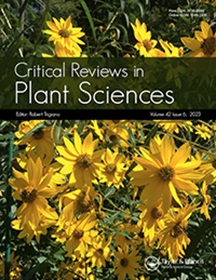火在空间和时间上对血清性和非血清性的选择性作用
IF 6
2区 生物学
Q1 PLANT SCIENCES
引用次数: 48
摘要
摘要:寄存是木本植物将种子长时间储存在封闭的球果或果实中。它广泛分布于以冬季降雨为主的易火植被中,特别是在地中海型生态系统(mte)中。非蓄能性是夏季降雨占优势的易火植被或非易火植被的特征。当回火间隔介于年龄到生殖成熟和植物寿命之间时,服务性赋予个体健康益处。物种内部和物种之间的服务水平沿连续体变化很大,表明对不同环境条件的高度可塑性反应。在这里,我们回顾了支撑这种生殖综合症的特征是如何以及为什么进化并继续控制当代景观中物种的发生。我们在澳大利亚、南非、地中海盆地、北美和亚洲的火灾易发地区记录了1345种浆液物种。种子贮藏期从几年(弱服务期)到10年(强服务期)不等,甚至在枝内也有显著的多样性。我们展示了火后和火间幼苗招募之间的相互作用如何决定了服务蛋白在强服务蛋白/非服务蛋白连续体中的表达,并且,在强服务蛋白受到青睐的地方,“对服务蛋白的基因支持”在连续几代中建立起来。在没有火的情况下,或者在超过植物寿命的间隔时间内发生,但当火如此频繁以至于只有呼吸机才能存活时,不服务是有利的。我们确定了23个与血清微素/非血清微素综合征相关的性状,这些性状受环境和系统发育的制约。虽然所有这些都是为了最大限度地适应而协调的,但有些特征,比如保护自己免受花岗岩动物的侵害,只与火灾制度间接相关。serviniy的历史很长,可以追溯到三叠纪。随着时间的推移,血清谱系的增殖率波动很大,但在过去的500万年里达到了顶峰。由于火灾频率的增加,或者随着植物向无火栖息地的迁移,非继发性物种从继发性祖先进化而来。我们注意到,当代气候、土地利用和开发利用的变化对MTEs中servous物种的保护状况和进化轨迹产生了深远但不成比例的影响。不断升级的人为影响增加了对一些易发火灾生态系统的重要特征的理解。我们强调了未来研究的途径,并主张使用基于时间的服务度量来促进研究之间的比较。本文章由计算机程序翻译,如有差异,请以英文原文为准。
Fire as a Selective Agent for both Serotiny and Nonserotiny Over Space and Time
Abstract Serotiny is the prolonged storage of seeds in closed cones or fruits held within the crown of woody plants. It is widespread throughout fireprone vegetation with a predominantly winter rainfall, especially in Mediterrnanean-type ecosystems (MTEs). Nonstorage is a feature of fireprone vegetation with summer-dominant rainfall or nonfireprone vegetation. Serotiny confers fitness benefits on an individual when fire return intervals fall between age to reproductive maturity and the plant life span. The level of serotiny within and between species varies greatly along a continuum indicating highly plastic responses to different environmental conditions. Here we review how and why the traits that underpin this reproductive syndrome evolved and continue to control the occurrence of species in contemporary landscapes. We documented 1345 serotinous species in fireprone regions of Australia, South Africa, the Mediterranean Basin, North America, and Asia. The length of seed storage varies from a few years (weak serotiny) to >10 years (strong serotiny), with remarkable diversity even within clades. We show how the interplay between postfire and interfire seedling recruitment dictates the expression of serotiny along a strong serotiny/nonserotiny continuum, and that, where strong serotiny is favored, the ‘gene support for serotiny’ builds up over successive generations. Nonserotiny is favored in the absence of fire or occurs at intervals exceeding plant longevity, but also when the fire is so frequent that only resprouters can survive. We identify 23 traits associated with serotiny/nonserotiny syndromes that are subject to both environmental and phylogenetic constraints. While all are coordinated for maximum fitness, some traits, such as protection from granivores, are only indirectly related to the fire regime. Serotiny has a long history extending back to the Triassic. The rate of serotinous-lineage proliferation has fluctuated greatly over time but peaked over the last 5 million years. Nonserotinous species have evolved from serotinous ancestors in response to increased fire frequency, or as plants migrated to fire-free habitats. We note that contemporary shifts in climate, land-use, and exploitation have had a profound, but disproportionate, effect on the conservation status and evolutionary trajectory of serotinous species in MTEs. Escalating anthropogenic impacts increase the need to understand how and why serotiny is such a prominent feature of some fireprone ecosystems. We highlight avenues for future research and argue for the use of temporally based measures of serotiny to facilitate comparisons between studies.
求助全文
通过发布文献求助,成功后即可免费获取论文全文。
去求助
来源期刊
CiteScore
12.90
自引率
1.40%
发文量
15
审稿时长
>12 weeks
期刊介绍:
Critical Reviews in Plant Sciences focuses on presenting in-depth and up-to-date reviews of timely and/or cutting-edge subjects in the broad discipline of plant science, ranging from molecular biology/biochemistry through the areas of cell biology, plant pathology and physiology, genetics, classical botany, and ecology, to practical agricultural applications. Articles in the journal provide an up-to-date literature base for researchers and students, pointing the way towards future research needs. The journal is also a significant source of credible, objective information to aid decision makers at all levels.

 求助内容:
求助内容: 应助结果提醒方式:
应助结果提醒方式:


